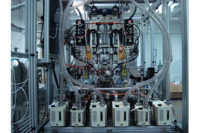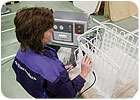
Leaks are never a good thing, especially in a home. Unfortunately, large appliances have numerous opportunities to leak every day.
Air conditioners, barbecue grills, dishwashers, faucets, furnaces, garbage disposers, ovens, refrigerators, washing machines, water heaters and other products have a wide variety of connectors, couplings, diaphragms, filters, gaskets, hoses, pumps, tubes and valves that can loosen or develop cracks, holes or porosity.
Any household appliance that contains a fluid or gas under pressure must be carefully tested. Some appliances pose complex leak testing challenges that are more typically associated with the automotive and medical device industries. And, new features that are designed to entice consumers, such as steam cleaning technology, are creating additional opportunities for leak testing applications.
To add to the challenge, leak specifications often change in response to new safety standards and environmental regulations. For instance, earlier this year, a new door gasket requirement took effect for dishwashers.
“It’s not so much one particular component that leaks,” says John Drengenberg, consumer affairs manager at Underwriters Laboratories Inc. (Northbrook, IL), which tests and certifies appliances, and issues numerous safety standards. “Most leaks occur at the interface, where gas, refrigerant or water enters the appliance. We see few leaks inside the actual devices.”
According to Drengenberg, an engineer who has been studying household appliances for more than 40 years, there are two main areas that require stringent testing. First and foremost are safety-related leaks.
This is extremely important in the case of gas appliances, which are like brakes on a car; even the slightest leak can be fatal. Every component and connection in the gas circuit is a potential leak point and, therefore, a safety concern. Another potential threat occurs whenever an electrical appliance uses water to operate, such as dishwashers and washing machines. Leaks can create an electrical shock hazard, which means that they’re a potential liability to manufacturers.
Appliances must also be leak tested to meet customer quality expectations and to proactively address warranty issues. For example, a slight defect in the casting of a bronze or brass kitchen faucet can cause cracks, resulting in considerable water damage.
While some tabletop appliances that use water, such as coffeemakers, may leak, large appliances are even more susceptible, because little leaks that can cause big problems. For instance, a leak inside a refrigerant line can wreak havoc on an air conditioner or a refrigerator. Loss of refrigerant dramatically affects performance, as well as creating environmental issues.
Today, all refrigerants used in the United States are nontoxic and nonflammable. However, in Europe, some appliance manufacturers use hydrocarbons as refrigerants.
“Europe leads the way in refrigeration leak testing requirements, of which some are or soon will be mandatory,” says David Morris, marketing manager at Alcatel Vacuum Products (Hingham, MA). “However, a number of American companies are meeting these stringent requirements without having mandates put upon them. Instead of testing installed systems with refrigerants, other gases, such as diluted hydrogen, are being used.”
In addition, all gas appliances used for cooking, drying or heating must be leak tested and flow checked to ensure that they are safe to use. There are dual safety issues with gas, since it is both toxic to breathe and flammable. However, natural gas appliances, such as water heaters and stoves, and propane gas appliances, such as outdoor barbecue grills, use different air-fuel ratios and operate on different pressures. And, natural gas is lighter than air and rises when it leaks, while propane is heavier than air and sinks.
Household appliances that dispense water, such as faucets and refrigerators, must also operate flawlessly. A leaky ice maker in a freezer or a faulty water dispenser in a refrigerator door can create a huge headache for consumers.
According to Drengenberg, water is the single biggest source of leaks at the consumer level. He says dishwashers are the most notorious appliance for leaking. “Most problems are due to gasket failure,” explains Drengenberg. “Water either leaks into the motor or it leaks into the door, which often contains electrical controls and electronics.” In fact, last year, there was a huge recall of Maytag dishwashers because liquid rinse aid was leaking behind its dispenser and shorting out some wires.
“Everything leaks somewhat; it’s just a question of how much is tolerated by performance specifications and environmental laws,” says Gordon Purkis, sales engineer at VTech North America (Alpharetta, GA). “A small refrigerator with a one-pound charge of refrigerant can’t afford to lose any refrigerant at all, since even an ounce or two will affect its performance.
“Typically, the standard for appliances is 0.1 to 0.5 ounce per year of refrigerant,” adds Purkis. “[Bigger things], such as rooftop air conditioning units, have larger charges, so they can afford to lose more refrigerant over time without having an impact on performance.”
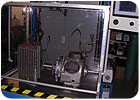
Helium is used to test a condenser coil and scroll compressor using an outside-in leak detector.
Complex Requirements
When most engineers think of leak testing, auto parts or medical devices usually come to mind. Traditionally, both of those industries have more complex requirements.For instance, production volumes tend to be much higher, which makes repeatability and reproducibility critical attributes of leak testing equipment. According to Jacques Hoffmann, president of InterTech Development Co. (Skokie, IL), the realities of the marketplace also dictate the way in which leak testing technology is applied on assembly lines.
Medical device assemblers must meet stringent FDA requirements and avoid the constant threat of malpractice lawsuits. Fuel pumps and other automotive components must operate under harsh conditions, and automakers must minimize the risk of warranty issues or recalls. For legal and regulatory reasons, automotive and medical device manufacturers are often forced to invest in precise leak detection equipment that can document factors such as accuracy and stability.
“There is less leak testing in the appliance industry than in the automotive or medical industries,” says Hoffmann. “That’s because performance requirements are less stringent.”
However, the appliance field has its own unique set of leak testing requirements. “The appliance industry is just as complex as any other industry,” argues Mark Spindler, product manager at FasTest Inc. (Roseville, MN). “Few items in our lives are subjected to the same demands as appliances. The industry offers a great variety of parts and many different styles. This variety creates many challenges for product evaluation and testing.”
“In many ways, appliance test requirements, such as sensitivity and cycle time, are similar to automotive,” adds Steve Palmer, marketing manager for vacuum technologies at Varian Inc. (Lexington, MA). “Medical devices frequently require higher sensitivity.
“There is a [growing] demand for increased sensitivity [in appliance leak testing], due to more stringent quality controls,” says Palmer. “At the same time, customers want to reduce the cost of the leak test process and their consumption of tracer gas.”
According to Chris Goebel, director of component sales at ULVAC Technologies Inc. (Methuen, MA), the appliance field is more diverse and more flexible in its testing applications than many other industries. For instance, the auto industry is overseen by numerous government regulations that mandate how a test is to be performed or to what level a leak is acceptable.
“Appliance manufacturers are free to choose the testing method [that best suits] their market or product type,” explains Goebel. “In many cases, a bubble test or pressure decay is acceptable for products such as water heaters, commercial refrigeration manifolds or ice makers. [On the other hand], helium testing is predominant in the air conditioner, refrigeration coil, condenser and evaporator segments.
“We have visited companies in Mexico using the bubble test method that accept a known 12 percent failure rate at intermediate component test level,” adds Goebel. “Running product through rework is more cost-effective [for them] than investing in capital equipment to statistically determine leak points.” But, Goebel believes the appliance industry has a large potential for test refinement in the next 10 years.
Environmental conditions also differ in various industries, which makes it difficult to say whether appliance leak testing applications are easier or more difficult. For instance, medical devices are typically assembled in air-conditioned clean room environments, where testing equipment is always provided with a clean, purified compressed air supply.
“In the appliance industry, even though work conditions have improved, plants do not always have air conditioning,” says Guy Dewailly, president of ATEQ Corp. (Canton, MI). “The work environment is not as clean. Leak testers have to be designed to measure correctly in a large temperature range, from a chilly morning to a warm afternoon, and from summer to winter.
“Automotive leak testers face approximately the same plant conditions as appliance leak testers, but the volume of the components tested is often larger,” adds Dewailly. And, most leak testing in both industries is done at the component or subassembly level.
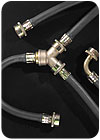
Appliances have numerous connectors, couplings, hoses and tubes that can loosen or develop cracks, holes or porosity.
New Applications
Appliance manufacturers are constantly looking for new features that differentiate their products from the competition. The goal is to help drive replacement demand in the marketplace.For instance, consider the humble refrigerator, which is a device that is constantly running. New consumer-friendly features, such as doors equipped with built-in computer screens and speakers, mean there are more opportunities for any potential leak to cause chaos.
Responding to legislative pressure, environmental initiatives, soaring energy costs and increasing consumer demand, appliance manufacturers are developing more energy-efficient products. The goal is to reduce excess electricity, gas and water consumption. As a result, engineers are experimenting with new components, such as coils, compressors, digital controls, evaporators, filters, motors, pumps, sensors and switches.
While it’s busy addressing 21st century sustainability issues, the appliance industry recently took a step back in time and entered the steam age. A wide variety of new dishwashers and washing machines feature steam technology to sanitize clothes, dishes, glasses, towels and other objects.
Traditional dishwashers generate steam in the drying cycle, but new devices also create steam in the wash cycle. Dryers equipped with steam help consumers get rid of odors and wrinkles without chemicals or ironing. Steam-assist technology is also available in ovens to help eliminate the need to mist and baste some types of foods, such as breads and roasts.
“Completely natural and highly versatile, steam is one of the most effective cleaners,” claims Blane Buckingham, director of marketing at Whirlpool Corp. (Benton Harbor, MI). The company recently unveiled a line of electric ranges equipped with a steam cleaning option that addresses consumer concerns about strong odors associated with traditional oven cleaning.
While all that steam creates new sales and marketing opportunities for appliance makers, it also creates more potential for leaks to occur, because a new fluid must be plumbed into the appliance. For instance, with dryers and ovens, assemblers must install a small nozzle that distributes water, in addition to pipes and valves.
Appliance manufacturers are also under more pressure to get new products to market faster than ever. As a result, engineers must speed up the entire process from design and development to testing and production.
“Leak testing fits at the end of this timeline, so there is not much time allowed to build custom equipment and install the equipment on the production line before the first products must be shipped,” says Gordon Splete, key account manager at Cincinnati Test Systems Inc. (Village of Cleves, OH). “Sometimes, we find ourselves redesigning machinery to accommodate product design changes.”
Splete also says more appliance manufacturers are trying to cut costs by using less expensive materials. “Plastic hose, line and fittings cost a lot less than copper,” he points out. “Copper tends to change temperature quickly, while plastics and composites are more consistent, which affects leak testing applications.”
The international nature of appliance manufacturing today also causes leak testing headaches for engineers. During the past few years, many companies have closed factories in the United States and Western Europe and moved assembly to low-cost countries in Latin America and Eastern Europe.
For instance, AB Electrolux (Stockholm, Sweden) recently announced that it will be discontinuing production at its cooker plant in Spennymore, England, and moving production to Swidnica, Poland. Earlier this year, GE Appliances (Louisville, KY) announced that it plans to close its 41-year-old refrigerator plant in Bloomington, IN. Many observers expect assembly operations will shift to Mexico when the plant shuts down at the end of 2009.
“Leak testers have to be able to work in a wide range of voltages, such as 110 or 230 volts and 50 or 60 hertz, since production is often moved from one country to another,” Dewailly points out. “They have to be able to work and give the same test results at sea level or in the Mexican altiplano. A tester has to be able to correct its measurement and display in standard conditions of atmospheric pressure and ambient temperature.
“This is crucial, since parts manufactured in one country are transported to another where they are assembled,” adds Dewailly. “The tester has to provide the same measurement. [It also has to display data] in multiple languages, have manuals in multiple languages, and have technical support available in these languages and time zones.”
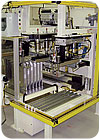
This test stand uses mass flow to check for leaks in heat exchangers used in gas furnaces.
Testing Challenges
Some appliance components are more difficult to leak test than others, and there’s no one-size-fits-all for testing equipment. Manufacturing engineers must determine what test to use for each application. For instance, pressure decay often works best for faucets, while mass flow is better for testing heat exchangers or gas furnaces. Helium mass spectrometry is better for air-conditioning condensers, while vacuum decay is more ideal for sealed components, such as sump pumps.Many observers claim that air conditioners and refrigerators pose the most challenges. “Refrigeration systems are particularly important [to test], as loss of refrigerant not only has warranty cost implications, but also impacts the environment,” says Morris. “Due to the tighter leak specifications in [these products], the test methods have to offer high sensitivity and production procedures have to be more stringent to meet these requirements.”
“Refrigeration appliances are the most difficult to test,” adds Dewailly. “These systems are sealed for life and the manufacturers are trying to extend the life of the refrigeration system without any service intervention to refill the system with fluid. The extremely low leak rates in these products require more expensive technology, such as tracer gas leak testers.”
“Air conditioning coils are probably the most difficult component to test,” claims Hoffmann. Specifically, rifled tube coils pose unique leak testing problems. The turbulent flow caused by the spiral improves heat transfer rates that result in a higher efficiency rating.
According to Spindler, the design allows manufacturers to create a tube that uses less material yet withstands high pressure. However, the sharp edges create crests and valleys that make it harder to accurately test for leaks.
Gas appliances can also be difficult to test. “The leak rates are at the lower limit of what can be done with air testing and the test conditions in plants (fans, temperature change, brazing operations before the test) are far from ideal for air testing,” says Dewailly. “Most of our customers want to use air tests, because it is safe and less expensive than other methods.”
Most testing in the appliance industry is done at the component level. That’s because on some products, such as refrigerators, gas ranges and stoves, it’s hard to reach critical joints and connections that need testing after the product is assembled.
“Appliance components are easier to test and pose less challenges to test than the fully assembled product, because they are smaller,” says Dewailly. Leak testing typically has less to do with the specific appliance than the size and shape of components.
“Typically, condensers, compressors and evaporators are smaller, so size is not a factor,” says Goebel. “Rather, automating the sealing, evacuation, fill, test and recovery of the test medium can be tricky. Extremely inventive designs can come into play in this arena.”
Rotisserie-style automated leak testers are common for small parts. However, Goebel says maximizing space and minimizing test time can be challenging.With larger appliances, such as refrigerators, commercial freezers and commercial air conditioners, the sheer size of the test piece comes into play.
Manufacturing engineers must consider which type of test procedure to use. For instance, should a chamber be used? Is sniffer leak detection better? The trade-offs are always test quality vs. capital investment.
“While a chambered system typically offers unparalleled test accuracy by the elimination of operator error, the cost of the equipment and floor space, as well as running costs, can be prohibitive,” says Goebel. “On the other hand, sniffer test methods employing helium as a tracer gas can be a less expensive capital investment with a smaller footprint.”
“Parts that are wet, dirty or oily can be challenging,” adds Palmer. “Oil can seal the leak. With many refrigeration components, you are dealing with high pressure, requiring strong fixturing and safety factors.”
Products that require more than one leak test or pressure add to the complexity. “Usually, these are valves or multiple port components, and it is necessary to open a valve, close the valve and verify open-close,” explains Rich Grady, vice president of marketing at Cincinnati Test Systems. “This requires additional inputs and outputs, and sometimes additional tooling motions or valves in the test line to pressurize and exhaust different ports.
“Sealing is also a challenge,” Grady points out. “Many customers need manually placed seal tooling. This tooling might be manually actuated sealing devices or pneumatically actuated. If the test pressure is too high, the seal may need to be backed up with a cylinder. If there is not enough room in the production line for this type of sealing mechanism, vendors may have to custom manufacture ways to mechanically fixture and hold the manual seal onto the part.” A

